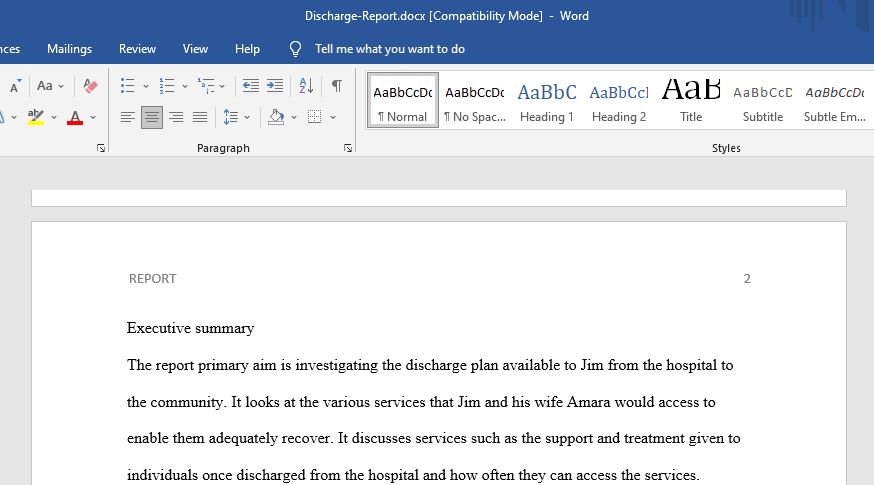Discharge Report
| Project Details | |||||
| Paper Topic | : | Discharge report | |||
| Style | : | Harvard | Language Style | : | English (U.S.) |
| Type of Assignment | : | Assessment | Deadline | : | 1 Days |
| Acedemic Level | : | Undergraduate Level | Number of pages | : | 5 |
| Number of Sources | : | 8 | |||
| Order Instructions | |||||
| Pay more attention in this assessment and hand out by 21st january. Use Scholarly references only. No random website for the content and reference. | |||||
In this assessment task, you will be facilitating Jim discharge from hospital to his home. Each student’s report will be different as Jim lives in the same suburb or town in which you reside.
For example, if you live in Norwood, Jim lives in Norwood, if you live in Sheffield, Jim lives in Sheffield. If you live in Woolloomooloo…
You will be exploring the services and options available in your local community.
- This assessment task is not only focused on Jim; as Jim was his wife’s carer prior to his admission you will need to consider what needs to be put in place to support Jim and his wife.
- This is not an essay, rather a report – which gives you the freedom to include images, tables, flowcharts, headings, forms etc. Please ensure your report has a logical flow.
- You may write your report in the first or third person (however do not swap between the two, be consistent).
- Jim wishes to remain in his own home, he does not wish and will not discuss the option of residential aged care for himself or Amara (Amara feels the same). Jim and Amara will also not discuss respite care options or moving to a smaller house or unit – they want to stay in their own home.
- Jim’s CVAD was removed prior to discharge.
- Please read the rubric for this assessment task
- Case Report Task Description In this unit you have been following the journey of Jim Karas from the acutecare hospital setting to his return to the community. This assessment requires you to develop a tailored discharge plan for Mr. Karas. He is being discharged home to the same suburb/town in which you live, and therefore you will need to seek information on services available to meet his (and his family’s) complex needs in your local community. You will need to consider the transfer of information between differing services during his care transition. Mr. Karas does not wish for his admission diagnosis to be disclosed or discussed.
CASE STUDY
RUBRIC
Criterion
- Selects a course of action for discharge and formulates a plan of care (30%)
Discharge planning
- Uses the shared transfer of care core principles
- Identifies location of discharge and explores specific local community services
Think about what discharge plan should be for a patient clear, unambiguous, easy to understand, well thought out.
- Report structure must be logical and can include headings, subheadings, tables,
flowcharts, images, dot points Provides a precise and comprehensive plan of care,
which considers Jim and his family’s care requirements.
Provides a comprehensive plan of care, which considers Jim and his family’s
care requirements.
- Demonstrates and applies legal & ethical principles to decision making, and
incorporates a strengths-based approach (40%)
- Considers communication in relation to the sharing and privacy of collected data
Framed in the principle of autonomy
- Incorporates the four main principles of strengths-based nursing
– Person centred care.
-Empowerment
– Health promotion and healing
-Collaborative partnership.
-Demonstrates exceptional exploration, critical analysis and application of the principles.
- Considers culturally safe care in the development of a plan of action care (10%)
-The code of ethics comes on handy for this criteria –Value statement three.
-As you go over jim case again for this assessment task reflect on cultural aspects that you think are pertinent in the development of a culturally safe plan of care.
-What may be barriers and facilitators?
Demonstrates a sophisticated & comprehensive understanding of the cultural
factors which may impact on the provision of care for Jim and his family.
- Writes in an appropriate academic style, substantiating work with literature and Harvard referencing (20%)
High level of academic writing with strong evidence of planning.
Discussion is consistently expressed in a clear and fluent manner.
Draws on a judicious selection of literature to inform and justify writing.
Accurately referenced all sources using the Harvard style, without error.
I have attached case study for this assessment in different pdf file. This case study is related with this assessment. Please read through the case study before doing the assessment. Please hand out the assessment on 21st thank you.
Answer preview:
Word: 1,900

